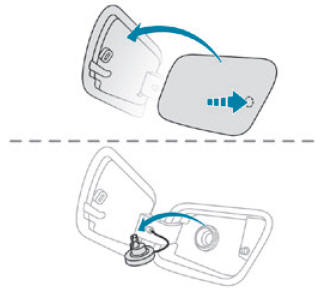Peugeot 2008: Practical information / Refuelling
Fuel tank capacity: approximately 44 litres (Petrol) or 41 litres (Diesel).
Reserve level: approximately 5 litres.
Low fuel level
 When the low fuel level is
reached, this warning lamp comes on on the instrument panel, accompanied by an
onscreen message and an audible signal. When it first comes on, about 5
litres of fuel remain.
When the low fuel level is
reached, this warning lamp comes on on the instrument panel, accompanied by an
onscreen message and an audible signal. When it first comes on, about 5
litres of fuel remain.
Until sufficient fuel is added, this warning lamp appears every time the ignition is switched on, accompanied by an onscreen message and an audible signal. When driving, this message and audible signal are repeated with increasing frequency as the fuel level drops towards 0.
You must refuel as soon as possible to avoid running out of fuel.
For more information on Running out of fuel (Diesel), refer to the corresponding section.
 Stop &
Start
Stop &
Start
Never refuel with the engine in STOP mode; you must switch off the ignition.
Refuelling
When refuelling, at least 5 litres must be added in order to be registered by the fuel gauge.
Opening the filler cap may create a noise caused by an inrush of air. This vacuum is entirely normal, resulting from the sealing of the fuel system.
To refuel in complete safety:
- Always switch off the engine.

- With the vehicle unlocked, press the rear-central part of the filler flap to open it.
- Take care to select a pump that delivers the correct fuel type for the vehicle's engine (see a reminder label on the inside of the filler flap).
- Turn the filler cap to the left.
- Remove the filler cap and hang it on its carrier (on the filler flap).
- Introduce the filler nozzle and push it in as far as possible before starting to refuel (to minimise the risk of splashing).
- Fill the tank.
Do not continue after the nozzle’s third cut-out. Doing so may cause malfunctions.
- Refit the filler cap.
- Turn it to the right.
- Push the fuel filler flap to close it.
 If
you have put in the wrong fuel for the vehicle, you must have the fuel tank
drained and filled with the correct fuel before starting the engine.
If
you have put in the wrong fuel for the vehicle, you must have the fuel tank
drained and filled with the correct fuel before starting the engine.
The vehicle is fitted with a catalytic converter, which helps to reduce the level of harmful emissions in the exhaust gases.
For petrol engines, you must use unleaded fuel.
The filler neck is narrower, admitting unleaded petrol nozzles only.
 Compatibility of fuels
Compatibility of fuels
Petrol fuels conforming to the EN228 standard containing up to 5% and 10%
ethanol respectively.
Diesel fuels conforming to the EN590, EN16734 and EN16709 standards and
containing up to 7%, 10%, 20% and 30% fatty acid methyl ester respectively...
 Misfuel prevention (Diesel)
Misfuel prevention (Diesel)
(Depending on country of sale.)
This mechanical device prevents filling the tank of a Diesel vehicle with
petrol.
Located in the filler neck, the misfuel prevention device appears when the
filler cap is removed...
Other information:
Peugeot 2008 2019-2025 Owner's Manual: Applications
USB ports Depending on equipment, for more information on the USB ports compatible with CarPlay®, MirrorLinkTM or Android Auto applications, refer to the "Ease of use and comfort" section. For the list of suitable smartphones, visit the Brand's national website...
Peugeot 2008 2019-2025 Owner's Manual: Locking the vehicle
Normal locking With the doors and boot closed, the vehicle locks: Either automatically, upon leaving zone B, if the automatic functions are activated. Or by gently pressing the driver's door handle. Locking is confirmed by the lighting of the direction indicators, and by an audible signal when the vehicle is locked upon walking away...
Categories
- Manuals Home
- 2nd Generation Peugeot 2008 Owners Manual
- 2nd Generation Peugeot 2008 Service Manual
- ISOFIX child seats. i-Size child seats
- Refuelling
- Manual child lock
- New on site
- Most important about car
